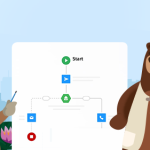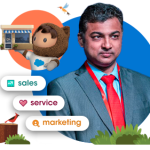At any given point in time, BPCL touches the lives of crores of Indians in their homes and outside. From cooking gas to aviation fuel, our six business divisions span commercial and retail, individual and organisational, as well as B2B and B2C customers.
And yet, we had no idea how these customers viewed BPCL. Did they view us as a single entity or as six disparate business units? We had 8.5 crore customers, but did we know their preferences? Were we offering each of them a personalised experience?
To answer such questions, in 2020, we set out to achieve our vision of One BPCL – ensuring that no matter which of our products customers used, they would know it came from a single brand, and would enjoy a singular, consistent, and seamless experience across touchpoints. We launched Project Anubhav (in Hindi, Anubhav means experience) because we realised only personalisation can set us apart in a market with muted demand. Only personalisation would make us the preferred choice for our customers.
To deliver personalised experiences, we needed a 360-degree view of our customers. The lack of this granular information was especially felt on the field, where our sales officers sometimes did not realise that the same customer needed products beyond those they were already buying from BPCL (such as industrial lubes as well as diesel or LPG). We realised that we were losing the opportunity to upsell and cross-sell.
And we knew that we needed technology to get such a 360-degree customer view.
Pivoting on technology for a better customer experience
Project Anubhav became the start of our digital transformation (DX) journey. No other company in our industry or size category had executed a digitalisation initiative like Project Anubhav. Through it, we achieved a singular view of the customer that helps us provide exceptional customer experiences, consistently. And Salesforce played a pivotal role in this transformation.
What we did was unprecedented: from rewriting business processes, to moving completely to the cloud, to building customer engagement for B2B and B2C segments on a common tech platform. This gives us a single view of the customer, and also allows customers to see us as one BPCL.
We learnt a lot of things on the journey and continue to do so. Two years into the project, we are sunsetting almost a 100+ systems and applications. These tools have been replaced with Salesforce’s suite of cloud-based solutions that give us the flexibility, scalability, and agility needed for business growth.
Read more about BPCL’s digital transformation story here.
Staying ahead of the industry in a digital-first world is now table stakes. Through my experience on Project Anubhav, I have realised that a well-thought-through, nimble change management plan is the key to any DX initiative’s success. Drawing from our many learnings, here are my key takeaways to help you succeed in your digital transformation and change management journey:
1. Centralise data control through restricted user access
DX for any company with multiple business units need buy-in from key executive sponsors and leadership. Particularly in industries where customer experience may be the only major differentiator, leaders must make the right technological investments and be the change drivers. When leaders steer change, their teams can easily align themselves to what needs to be done. At BPCL, the heads of the different business units and senior leadership were completely invested in the company’s digital transformation, and drove a mindset shift.
Transformation cannot be the remit of the IT function alone – it needs active participation from the business.
Similarly, you need to involve the end users and employees at different levels whose work will be impacted by technologies you adopt. Ask each business unit what their requirements are and get them involved in creating the solution. This way, you share the ownership of continuity and successful implementation.
2. Identify the right tech solution for your organisation
If your business belongs to a traditional industry, it is likely you still rely on legacy systems that are no longer effective. Look for replacement tools that can automate processes, improve visibility into critical data, and scale up seamlessly when required.
BPCL previously relied on homegrown systems to serve customers. All our teams were working in silos, which meant we were missing out on massive cross- and upselling opportunities, as well as the chance to differentiate ourselves based on a seamless customer experience. We chose Salesforce to help us overcome these challenges. With it, we’ve unified all business units and teams around a shared customer view. Each team member now has all the customer data they need at their fingertips to deliver consistently great experiences across touchpoints.
3. Go with an out-of-the-box solution to reduce costs and customisation effort
When starting out, try and opt for pre-built solutions rather than focusing your resources, time, and effort on heavy customisation. At times, an out-of-the-box solution may involve tweaking your business processes. If this is expected to improve efficiency and productivity, discuss it with the other stakeholders in the organisation, and have the courage to make that leap.
Make customisations only when necessary. This will save you time and cost.
4. Get a reliable project consultant on board
Depending on the scale or complexity of your DX project, you might need the help of a consultant. They need to be experienced in handling DX projects like yours. They should also be able to give you a clear roadmap for timely and effective transformation.
After much consideration, we went with Deloitte who helped us set the project in motion. Within 20-25 days, we conducted workshops with all six business units to get their take on what constitutes an exceptional customer experience.
We also worked with 400+ people over six workshops to identify 22 use cases of how we could deliver the customer experiences we had envisaged. The use cases cut across all our business units, and we decided to unify them on a common platform – Salesforce. Deloitte helped us make these and other decisions with great speed. More than 9,000 business processes have been rewritten since.
5. Drive adoption through organisation-wide involvement right from the start
In our case, we created steering and core committees with representation from all business units and tech partners for smoother decision making. These committees grew from eight members at the start of the project to over 20 members now. Through them, we’re building consensus regarding everything – from choosing the right solutions to use cases – among employees at every level, especially business users at the grassroots level. We want our employees to become digital adoption drivers.
Along with conducting workshops and training sessions, and creating interactive training material and user generated content, we extensively used WhatsApp and Chatter for better coordination and collaboration on the project. To maximise adoption, we launched the annual Sales Buddy Shining Star Championships for the field sales forces across business units. Gamifying and incentivising the usage of Salesforce solutions helped us drive adoption from 80% to over 95%.
We want our employees to become digital adoption drivers.
6. Choose speed over wanting to get it all right
Our Chairman and Managing Director, and visionary thinker behind Project Anubhav, Mr. Arun Kumar Singh, always says, “Roll out if you are 85-90% there”. Roll out in time and welcome feedback on customer-facing solutions. This can get you customer buy-in and keep the solution relevant for longer. Improving functionality fast is important to meet customers’ evolving needs. If you fail, you fail quickly and can improve quicker. Roll out if you are 85-90% there At BPCL, we deployed Sales Cloud across five business units in a record five months. This was possible only because of continuous collaboration between Salesforce and BPCL.
7. Focus on solving customer problems
Always base your digital transformation on what customers want, not just what you want to offer.
With Salesforce, we streamlined both B2B and B2C customer engagement via a common front-end – Urja, our AI / NLP-enabled BPCL chatbot. We also brought down our customer enrolment process from seven steps to two. Using data from multiple channels, we pre-populated customer forms, so that the customer wouldn’t have to waste time keying in their data. And whenever a customer needs a fuel station, Urja helps them identify the nearest available outlet based on their pincode. These are some of the ways we are using technology to deliver better customer experiences.
Always base your digital transformation on what customers want, not just what you want to offer.
From an internal perspective, all the leads from Urja flow directly to Salesforce, helping us respond to them faster. We are now looking to do all reports and reviews at an organisation-wide level only through Sales Buddy – our internal name for the Salesforce platform.
The success of our tech implementation: we now have 5 million Urja users. And transactions worth over 30 crores have happened through our chatbot.
Behind every successful digital transformation journey are the right technology partners and a consensus-led top-down approach that will ensure organisation-wide tech adoption and streamline the employee and customer experience. Remember, customers will only be loyal for so long as you can give them something your competitors can’t, and technology can help you create that differentiating factor. Great customer experience is the holy grail for any business today, and having a digital-first approach is table stakes, even for PSUs.

























